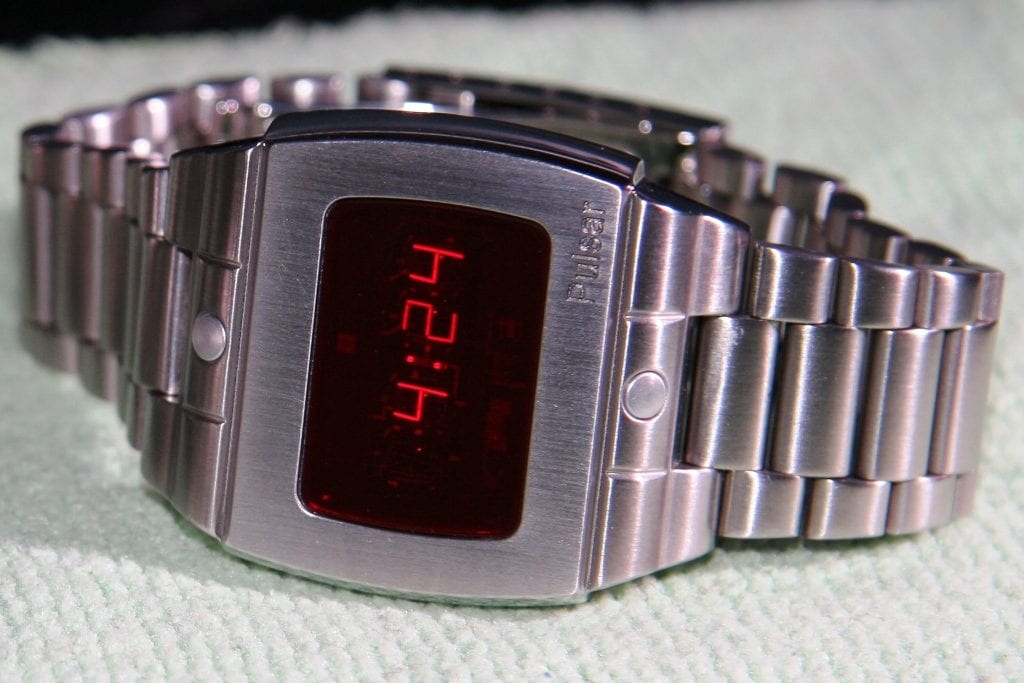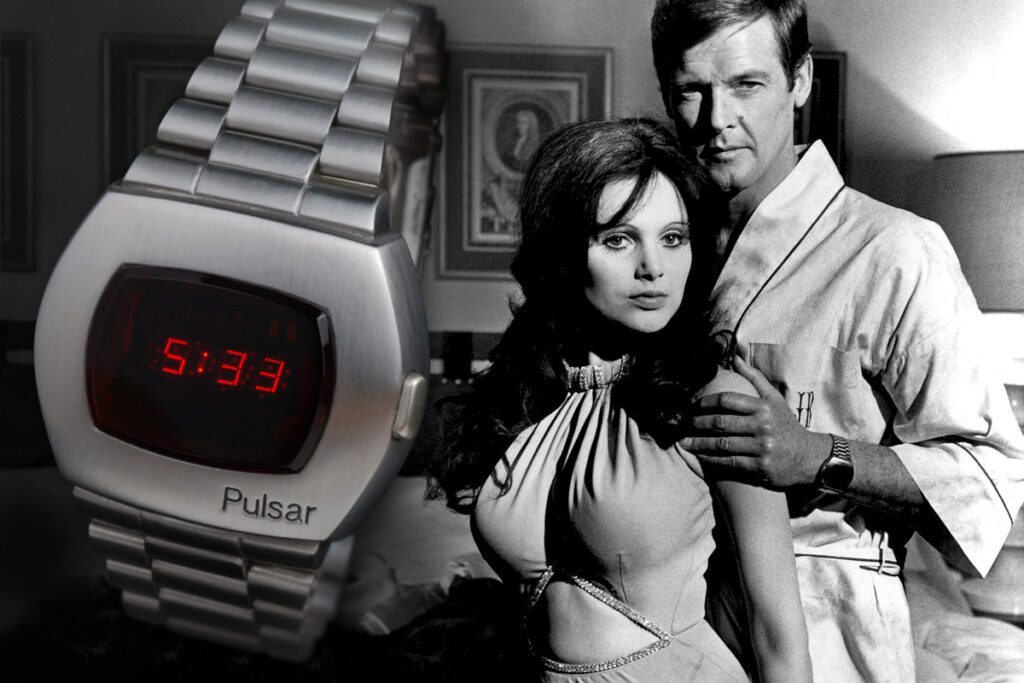The History Of The Pulsar LED Time Computer
A Pennsylvania company, from Lancaster, along with help from Electro-Data, Inc., of Garland, Texas, created a masterpiece in horology, launched in 1972, that stands as America’s biggest watch success story. The shiny, new Pulsar – announced the Pulsar Time Computer, billed as the world’s first digital watch.
How did an American brand accomplish such a feat? As the story goes, director Stanley Kubrick asked the Hamilton Watch Company to create a futuristic digital clock for his 1968 film, ‘2001: A Space Odyssey’. The film was a huge success and became the highest-grossing picture of 1968, however, the oval clock, that Hamilton produced, with glowing red digits captured the public’s attention, in its own right.
The digital clock, created for the film, inspired the creation of a watch with a similar display. The first ‘Wrist Computer’ was unveiled on Johnny Carson’s ‘The Tonight Show’ on May 5, 1970, however, Carson was not impressed, stating, ‘The watch will tell you the exact moment you went bankrupt!’ after learning of the impressive $1,500 USD price tag, for the prototype, as he threw it over his shoulder.
At the time, anything that sounded like a computer on your wrist seemed right out of science fiction. After all, computers were still enormous. The new Pulsar, was unlike anything the world had seen, featured 44 integrated circuits, 4,000 bonding wires plus seven ceramic circuit boards, each with its own function. The time-keeping signal was supplied by a quartz crystal vibrating at 32,768 Hertz, about three times the frequency of crystals being used in electric analog watches allowing the time to deviate by no more than three seconds a month, making it the most accurate watch in the world. It was the first watch to display time in a digital format, using light emitting diodes, or LED. The sales presentation was simple, the LED had three, or four, red digits indicating the hours and minutes that appeared on the screen for slightly more than one second and then blinked off. Magic!

It took Hamilton two years to bring the Pulsar to market, a name chosen to imply space-age technology, calling it ‘The Time Computer’. In April, 1972, a full-page ad in The Wall Street Journal announced that the wrist computer was on sale at a whopping price of $2,100 USD – equivalent to over $14,000 in today’s world. To bring that into perspective, that was more than a Ford Pinto, at the time, and $150 more than a top-of-the-line Rolex, too. The anticipated launch included upscale retailers, like Tiffany’s and Neiman-Marcus, who carried the watch. Hamilton manufactured 400 units for the arrival and sold out in 3 days! The factory soon followed the original 18-carat gold watch with gold-filled case models priced less, at $1,275 USD, and steel-case models at $275 USD.
In late 1972, Hamilton reorganized, and named John Bergey as President, making Pulsar its own subsidiary called the ‘Time Computer Inc.’, separate from their traditional watch division. By the end of the year, the company was selling thousands of units per month, outselling every high-end watch in the world. It was also the first watch imported into Switzerland, the famous watch-making country – a significant feather in the cap.

By 1973, the watch reached new heights, on the wrist of James Bond, played by Roger Moore, in the movie ‘Live and Let Die’ featuring a Hamilton Pulsar P2. The watch can be seen on Bond’s wrist in the first scene when James checks his watch to see what time it is. The viewers can see how the watch works – to see the time, Bond pushes the button on the side of the watch, so that the LED time lights up.
In May 1974, HMW Industries, the parent company to Hamilton, doubled down on their LED success and sold the Hamilton brand to the Omega and Tissot Holding Company, SSIH, which later became The Swatch Group, while holding onto their newly formed Time Computer Inc. ( Yes, Hamilton remains one of the Swatch Group’s watch brands, today, eventually moving their HQ and production, in 2003, to Biel, Switzerland ) The decision to sell seemed safe, early on – by the end of 1974, Pulsar sales exceeded $17 million USD and, in 1975, soared even further to $25 million on sales of 150,000 watches.
In its brief existence, the Pulsar Time Computer launched several versions of their watch: The P1 model, marketed in 1972 – the world’s first electronic digital watch. The P2 model, marketed in 1973 – the world’s first successful, mass-produced digital watch. The P3 model, marketed in 1973 -the first LED watch with date. The P4 Executive, marketed in 1975 – a smaller version of the P3. The Pulsar Time Computer Calculator – the first electronic calculator watch – which launched, in late 1975, as an 18-carat gold ‘limited edition’ version and sold for Christmas, that year, for an enormous price of $3,950 USD. It was a huge success, as well. The first Pulsars were marketed to men, however, there was a lady’s Pulsar version, too, launched in 1974.
By this time, America was leading the global quartz watch revolution: The Pulsar watch was re writing the watch industry playbook. Texas Instruments, from Dallas, was supplying digital LCD modules to Switzerland’s Ebauches SA, now called ETA. From 1972 to 1974, Omega had purchased 30,000 LED modules from Pulsar to use in Omega Time Computer watches – the first LED watch introduced to Europe.
In 1976, in a stunning development, Texas Instruments dropped its LED prices to $19.95. The next year, they cut LED prices again, to $9.95. Large scale production had dramatically lowered the cost of digital modules. Consumers eventually found that having to push a button to read the time was cumbersome, and by 1977 the LCD display had overtaken the market. Texas Instruments’ age-old strategy worked – lower prices. A policy of cut-throat price cutting that wiped out competitors.
After various corporate moves, the Pulsar LED would go out of production, in 1978. The Pulsar brand joined the Seiko Watch Corporation family, in 1979. Today, the brand continues as a division of Seiko which is among the leading watch brands throughout the world.
The American LED watch phenomenon deserves its place in watch history. In fact, the Smithsonian Institution, the world’s largest museum, education, and research complex, located in Washington, D.C., exhibits the prototype, for the original Pulsar watch, as an important contributor to the technology of quartz watches.

